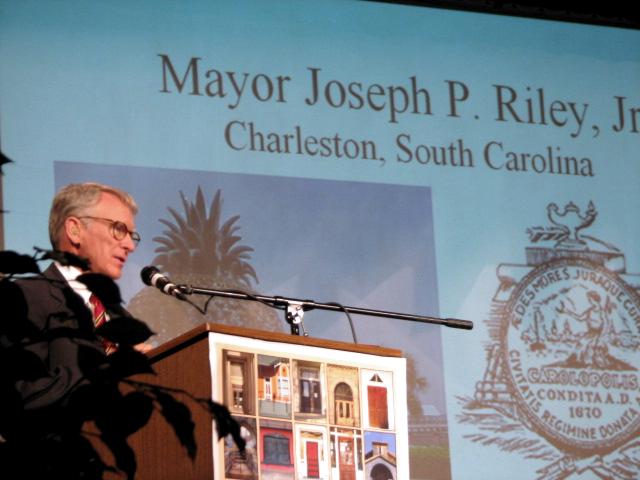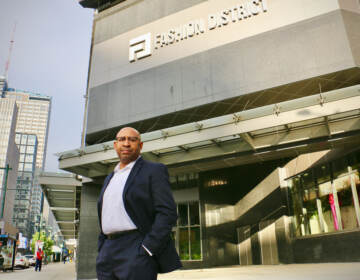Meet Joe Riley, a man with a message

Feb. 15
By Thomas J. Walsh
For PlanPhilly
When people say that Charleston, S.C. Mayor Joe Riley presided over the re-birth and re-design of his city for more than three decades, they mean it literally. Riley was elected in 1975 and has been mayor ever since.
Riley also literally put himself between a wrecking ball and a historic structure, more than a few times, to help revitalize entire city blocks and neighborhoods. For planners, architects and designers, he not only put Charleston on the map, he literally changed the map in profound ways, creating a world-class waterfront, converting dead zones to dozens of park spaces and mixing low-cost housing with historic preservation, all to vibrant effects.
“A city should be a place where every citizen’s heart can sing,” Riley said, Thursday night at Penn’s Houston Hall. He was introduced by Mayor Michael Nutter, who was hosting the Mayors’ Institute for City Design (www.micd.org) through Saturday (Feb. 14). Several mayors from across the country gathered to work with leading design professionals to study their cities’ planning issues. The Philadelphia City Planning Commission partnered with PennPraxis, the Community Design Collaborative, the Academy of Natural Sciences and others in sponsoring the events.
After more than 20 years in existence and more than 40 events, it was the first time Philadelphia played host. “It’s a big thing for us,” said Nutter, who called Riley “a complete mayor” and “the whole package.”
“We are honored and thrilled to be the host city.” Reiterating a sentiment he has repeated often, Nutter said one of his goals is to make Philadelphia once again the nation’s premier location for solid planning and design work. “We are planning to take our number 1 spot back.”
Riley was a founder of MICD in 1985, and because of that – and his longevity in a position that is rarely longer than eight years – he is no ordinary politician. He is more like Charleston’s head coach as well as its head designer. And the guy can give a pep talk like nobody’s business.
Employing a rich southern accent just a touch shy of folksy, he rambled through stories and experiences, garnering laughs when matters got bureaucratic, and pushing through a slide show that was not technical. When he spoke of the citizens of Charleston, though, his cadence slowed and his voice softened, at times to the point of a whisper. It is the people of the town who have motivated him to seek out the best design of cities, always the people, he said.
Mayors must deal with annual budgets and the day-to-day life of their cities – important duties but ones that will be lost to time. “The decisions we make on the physical shape of our city will last forever,” he said. “But we don’t come to office usually having been trained in this.”
The MICD was a product these hard-head / soft-heart sentiments, and eventually funded by the National Endowment for the Arts.
“We can’t let America become a place where the good stuff is only in the private realm,” he said.
Do what you need to do, he said. Buy up a whole block of properties if warranted, to save one of them and initiate investment in the rest. The town of Charleston did that plenty of times. The town even once owned a fully operational strip bar as a result. City employees inspected it once a week, he reported, garnering a few guffaws.
At the end of the talk, Riley was asked a few questions, one by Terry Gillen, Mayor Nutter’s senior official for economic development. Reflecting on decades of change in Charleston and his constant presence as mayor, she wondered what systems he might have set up for the eventual time when he was no longer mayor. It was an excellent question, but it proved a hard one for Riley to answer. The thrust seemed to be that he had the right people in place, and that there was trust. Yet one of the things he said at the start – that Charleston never really experienced the industrial revolution – spoke volumes about the differing challenges facing Philadelphia, the one-time “Workplace of the World.”
One of Riley’s big successes, though it is difficult to separate from the rest of the city, was Charleston’s Waterfront Park. It was an aging part of town with battered warehouses and crumbling wharves. It is now the city’s 12-acre crown jewel for both residents and tourists. “In our cities we have so many people who only have their city,” he said.
How it came to be? It involved plenty of money, mechanics and deft maneuvering. But if you ever meet Riley, ask him about a certain man afflicted with epilepsy, among other ills, who was not only an inspiration to him, but a guest of honor at the park’s grand opening – the last time he saw him. The man, a certain Mr. Hopkins who scratched out a living as a cleaner and lover of shipping traffic, was a citizen whose heart sung in an offbeat but consistent fashion, like a bird that annoys you at 5:15 a.m. but may become a source of beauty.
Riley, while giving another story about another citizen, said that if you hear poor people in your city thank you for something that they tell you is “beautiful,” with that word, voice trailing off, you’re on the right track.
“Work hard to keep the bulldozers out,” he said. “When you let it go, it’s gone forever.”
One more anecdote, which, via Google search, it appears he’s been telling for years. A low-slung corner liquor store, in a borderline neighborhood, not inviting in a warm pub kind of way but “kinda cool, you know,” was the scene for another epiphany. While he was making his “modest purchase,” he noticed two men, who may or may not have worked for the establishment, both bearing visible handguns, approach from either side, more or less simultaneously.
If he felt in danger, he let this audience feel it while he spoke of the men. They leaned on the counter, stroked their chins, stretched, and suggested that a certain big expanse of street at a nearby intersection, ugly with speed-bumpy objects in the road, and, you know, Mr. Mayor, not very walker friendly, might become one of those nifty little pocket parks they had seen.
“These guys in the corner liquor store, with pistols, wanted to talk about … beauty. It’s basic, it’s human, and our people will support it.
“America is an urban nation.”
Contact the reporter at thomaswalsh1@gmail.com.
ON THE WEB:
Daily News coverage:
http://www.philly.com/dailynews/opinion/20090211_City_design_comes_to_Philly.html
Phillyist http://phillyist.com/2009/02/10/stimulate_this_preview_of_panels_on.php
Inquirer, Feb. 9: http://www.philly.com/philly/news/local/20090209_In_Phila___mayors_to_discuss_urban_wish_lists.html
2007 Charleston City Paper (on Riley): http://www.charlestoncitypaper.com/gyrobase/Content?oid=oid%3A35088
NPR (2002; “All Things Considered”): http://www.npr.org/programs/atc/features/2002/may/city_design/index.html
1997 Boulder, Colo presentation: http://www.walkablestreets.com/riley.htm
City of Charleston: http://www.charlestoncity.info/dept/content.aspx?nid=495
WHYY is your source for fact-based, in-depth journalism and information. As a nonprofit organization, we rely on financial support from readers like you. Please give today.




